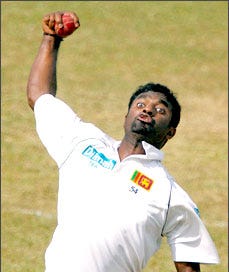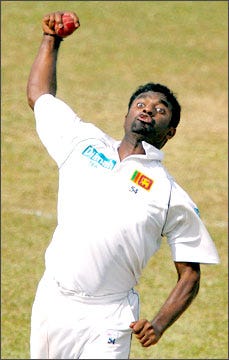Since it is the holiday season, I wanted to leave the faithful Stats Corner readers with something to smile about (check our best moments video here). And so, I had initially planned to write about just how good Matheesha Pathirana has been as a T20 bowler using all sorts of fancy stats from Himanshu Ganjoo’s database (stay tuned, it’s coming in the New Year). But then a poll popped up on X asking who was Sri Lanka’s all-time greatest cricketer. Murali, Sanga, Aravinda, or Sana?
With apologies to the Sanga, Aravinda, and Sana, the answer is, without question, Murali. His consistency, longevity, and dominance across formats, across conditions are unrivalled. No player has ever won more matches for his side and the marks he left on the cricketing record books are, simply put, indelible.
Now you all know the headline numbers (133 matches, 800 wickets, 22.72 average, 67 5-fers, 22 10-fers), but my gift to you this holiday are five obscure Murali stats that show just how insanely good he was:
3: The number of 10-fers that Murali took in six Test matches in England. For reference, that’s the same number of 10-fers that Jimmy Anderson (188 Tests) and Stuart Broad (167 Tests) took in their careers. If he played as much as Warne did in England, who knows what those numbers would look like…
5: The number of 10-fers that Murali took in 18 Test matches in England, South Africa, and New Zealand. That equals the career tally of 10-fers taken by Wasim Akram (104 Tests), Waqar Younis (87 Tests), and Dale Steyn (93 Tests). Though much is made of Murali’s struggles in Australia, we should not forget how good he was in “seaming” conditions elsewhere in the world. He was a match-winner in all conditions.
17.80: Murali’s average at home from 2000–06. He took 285 wickets in 37 matches in that span, averaging more than four wickets per innings. He produced 28 5-fors and 12 10-fers (which would, in fact, be the most all-time) in that span. For comparison, during Ashwin’s seven year peak (2015–21), he played 34 matches at home, taking 205 wickets at 20.14 with 15 5-fors and 4 10-fers. 🤯
48.2: Murali’s strike rate in test matches in England. It is often said that the reason why Murali took so many wickets was that he bowled a huge number of overs. That is partially true. But he also took his wickets quickly. Murali’s strike rate in England is better than the likes of Waqar Younis (48.2), Michael Holding (48.8), Dennis Lillee (50.1), Andy Roberts (50.3), Jasprit Bumrah (51.9), Shane Warne (52.3), Dale Steyn (55.4), Curtly Ambrose (55.8), Richard Hadlee (58.7), Wasim Akram (63.9), and Brett Lee (64.4). Not bad company.
105: Wickets taken by Murali against India during his Test career. Murali’s middling average (32.61 — much better than Warne’s 47.18) against India during the period has been another way that pundits have tried to poke holes in his career. But this critique needs to be properly contextualized. India’s batting, which consisted of the likes of Sachin, VVS, Sehwag, Dravid, Ganguly, Azharrudin, and others reigned supreme against spinners in this period, averaged 44.54 against spinners over the course of Murali’s career. In these 18 years, no other spin bowler took more than 43 wickets against India and only three bowlers who took more than 15 wickets had a better average: Paul Adams, Saqlain Mushtaq, Ajantha Mendis (all of whom quickly found themselves out of their respective sides when they were figured out). His ability to consistently take wickets against the best players of spin in the world is why Sachin and Sehwag regard him as the toughest bowler they ever faced.
Take these stats and go proselytize the gospel of Murali all over the globe, accepting from no one that Warne was a better bowler.




